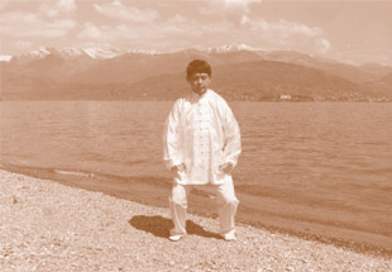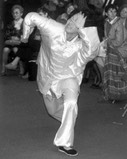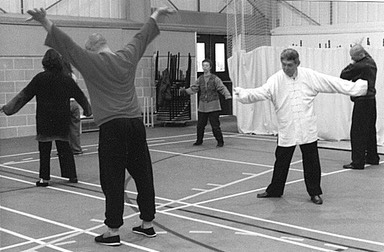We are hardly ever aware of the fact that spontaneous movements are a constant part of our daily life. The pumping of the heart, the breathing and the peristaltic movement of stomach and intestines are all examples of these 'natural spontaneous movements'.The body also uses spontaneous movements as an auto-regulating function, to restore balance: when the eyes get too dry, they blink, when the body is tired, we yawn and stretch the spine, when something disturbs the throat we cough etc. This natural spontaneous movement usually does not occur in other muscles than those associated with these specific activities.
We can distinguish two modes of motion in the human body. One is controlled consciously by mind through the motor centre in the brain and is called voluntary motion. The other is spontaneous, not controlled by the mind but automatic motion, balanced by the sympathetic and parasympathetic nervous systems, and is called involuntary motion. These two modes of movement are linked to two types of muscles that exist in the body: voluntary muscles that are controlled by the mind, such as the skeletal muscles, and involuntary muscles that are not controlled by the mind, such as visceral muscle. In some special cases this normal course can be reversed.
There is, however, another kind of spontaneous movement. During exercise a special body posture, in combination with breathing and a specific mental attitude, can result in a spontaneous movement which will spread throughout the whole body. This phenomenon we call 'induced spontaneous movement'. For us the term 'spontaneous movement' will hereafter refer to 'induced spontaneous movement'.
You can try the position shown in the picture, putting the body weight in the front of the feet, leaning forward a bit, relaxing the muscles of the legs and emptying the mind. If the legs and abdomen are sufficiently relaxed, one can feel a force coming from the feet through the legs to the abdomen. This force can cause two kinds of reactions, body movements - internal and external -and emotional release.

The internal movement can provoke sensations such as cold, wind, itching and warmth moving in certain areas of the body. When directed to the hands and feet, we can often see the hands changing colour and becoming red or blue, or white blotches under the skin, later returning to their normal colour. We call this a binqi (negative QI) reaction. Usually the internal movement develops through the body, starting with vibrations, later on followed by jumping, kneeling, prostrating, or some other beautiful movements as dancing or martial postures, and finally the person wants to sit or lie quietly. In general in young people the movement is quite strong, whereas in older people it is rather slow and gentle.
Continual quieting of the mind in this position will release emotional information. People may start to cry, scream, sigh, and later on laugh and sing. Belching, yawning, shouting, laughing crying and sweating can often accompany these emotional releases.
After one or several sessions of spontaneous movement, people can feel great changes in the body. Most students report that the body feels much lighter than before. Students with prior illness often have symptoms such as pain, itching and swelling diminished and even disappeared. Physical and emotional tensions which have accumulated in the body can be eliminated, and the emotional state changes from negative to positive. Moreover, spontaneous movement exercises can very often improve cases of chronic and difficult diseases which normal medicine or TCM have not answered. Spontaneous movement can help in athletic competition, artistic disciplines such as calligraphy, dancing, acting, singing, painting, and so on.

We can get spontaneous movement through standing, sitting, lying down or movement exercises. The key to receiving spontaneous movement is the activation of the dantian. Ancient Chinese think that a certain area in the belly - the dantian - is the centre of the Yuanqi. (often translated as 'original or vital energy'). They locate this dantian half way between the navel and the pubic bone in the straight abdominal muscles. Their idea of health is that one should save Yuanqi in there. This area is the centre of the abdominal triangle. We know it is a very active physiological centre: through a nerve branch it is connected to the adrenal glands influencing the entire energy system of the body; it is linked to the lymphatic system, so also to the production of immunity substances, etc.
The force of any body movement can connect to the dantian and hence activate the energy system, even so with the force of breathing, thinking, etc. The earth has a force that can influence the dantian through the legs. All these forces emit a different frequency. These frequencies can find resonance with the hidden frequency of the straight abdominal muscles, amplifying the vibration in that area. This vibration spreads out to neighbouring parts, and even throughout the whole body. For beginners this can take some time, but during lessons the teacher can transmit vibration force to help activate the dantian.
We have three major techniques to activate the dantian. Firstly, deep breathing, because it creates a pressure on the diaphragm that can excite the dantian area; secondly mental concentration on the dantian area. Finally, the most important technique, the lowering of the centre of gravity into the dantian, a Chinese way of saying is 'the centre of gravity kisses the dantian'. This last method makes it possible for the body to connect with the earth force and hence giving strong reactions. It also makes the balance more stable and is of major importance in Tai Chi.
With more practice, the dantian force gets stronger and can then slowly link to the movement of the body. When the force develops, it can rush upwards into the central channel and remove emotional information. Different positions can send this force through different channels and activate the small circulation and the left/right circulation.

Spontaneous movement is a natural quality of the body that can keep us healthy and even cure illness if we understand how to use it. During and after exercises binqi starts moving freely in the body, and we must give outward direction and open the hands to let the binqi exit the body. If we do not practice correctly, thinking we have to keep the Chi in the body or thinking it is a relaxation exercise, it can cause uncomfortable reactions. It is like a wild horse, powerful, but needing direction and control to be ridden so that it can take you where you want to go.....
Enquiries: email here
